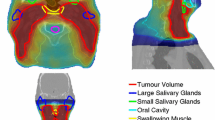Abstract
The segment minimization problem consists of finding the smallest set of integer matrices (segments) that sum to a given intensity matrix, such that each summand has only one non-zero value (the segment-value), and the non-zeroes in each row are consecutive. This has direct applications in intensity-modulated radiation therapy, an effective form of cancer treatment.
We study here the special case when the largest value H in the intensity matrix is small. We show that for an intensity matrix with one row, this problem is fixed-parameter tractable (FPT) in H; our algorithm obtains a significant asymptotic speedup over the previous best FPT algorithm. We also show how to solve the full-matrix problem faster than all previously known algorithms. Finally, we address a closely related problem that deals with minimizing the number of segments subject to a minimum beam-on-time, defined as the sum of the segment-values. Here, we obtain an almost-quadratic speedup.
This work was supported by the “Actions de Recherche Concertées” (ARC) fund of the “Communauté française de Belgique”, and the National Sciences and Engineering Research Council of Canada (NSERC). C.E. acknowledges support from the “Fonds pour la Recherche dans l’Industrie et l’Agriculture” (F.R.I.A.).
Access this chapter
Tax calculation will be finalised at checkout
Purchases are for personal use only
Preview
Unable to display preview. Download preview PDF.
Similar content being viewed by others
References
Baatar, D., Boland, N., Brand, S., Stuckey, P.J.: Minimum cardinality matrix decomposition into consecutive-ones matrices: CP and IP approaches. In: Van Hentenryck, P., Wolsey, L.A. (eds.) CPAIOR 2007. LNCS, vol. 4510, pp. 1–15. Springer, Heidelberg (2007)
Baatar, D., Hamacher, H.W.: New LP model for multileaf collimators in radiation therapy. In: Contribution to the Conference ORP3. Universität Kaiserslautern (2003)
Baatar, D., Hamacher, H.W., Ehrgott, M., Woeginger, G.J.: Decomposition of integer matrices and multileaf collimator sequencing. Discrete Applied Mathematics 152(1-3), 6–34 (2005)
Bansal, N., Coppersmith, D., Schieber, B.: Minimizing setup and beam-on times in radiation therapy. In: Díaz, J., Jansen, K., Rolim, J.D.P., Zwick, U. (eds.) APPROX 2006 and RANDOM 2006. LNCS, vol. 4110, pp. 27–38. Springer, Heidelberg (2006)
Biedl, T., Durocher, S., Engelbeen, C., Fiorini, S., Young, M.: Faster optimal algorithms for segments minimization with small maximal value. Technical Report CS-2011-08. University of Waterloo (2011)
Biedl, T., Durocher, S., Hoos, H.H., Luan, S., Saia, J., Young, M.: A note on improving the performance of approximation algorithms for radiation therapy. Information Processing Letters 111(7), 326–333 (2011)
Brand, S.: The sum-of-increments constraint in the consecutive-ones matrix decomposition problem. In: Proceedings of the 24th Symposium on Applied Computing (SAC), pp. 1417–1418 (2009)
Cambazard, H., O’Mahony, E., O’Sullivan, B.: A shortest path-based approach to the multileaf collimator sequencing problem. In: van Hoeve, W.-J., Hooker, J.N. (eds.) CPAIOR 2009. LNCS, vol. 5547, pp. 41–55. Springer, Heidelberg (2009)
Chen, D.Z., Hu, X.S., Luan, S., Naqvi, S.A., Wang, C., Yu, C.X.: Generalized geometric approaches for leaf sequencing problems in radiation therapy. In: Fleischer, R., Trippen, G. (eds.) ISAAC 2004. LNCS, vol. 3341, pp. 271–281. Springer, Heidelberg (2004)
Collins, M.J., Kempe, D., Saia, J., Young, M.: Non-negative integral subset representations of integer sets. Information Processing Letters 101(3), 129–133 (2007)
Cotrutz, C., Xing, L.: Segment-based dose optimization using a genetic algorithm. Physics in Medicine and Biology 48(18), 2987–2998 (2003)
de Azevedo Pribitkin, W.: Simple upper bounds for partition functions. The Ramanujan Journal 18(1), 113–119 (2009)
de Berg, M., Cheong, O., van Kreveld, M., Overmars, M.: Computational Geometry, 3rd edn. Springer, Heidelberg (2008)
Engel, K.: A new algorithm for optimal multileaf collimator field segmentation. Discrete Applied Mathematics 152(1-3), 35–51 (2005)
Kalinowski, T.: The complexity of minimizing the number of shape matrices subject to minimal beam-on time in multileaf collimator field decomposition with bounded fluence. Discrete Applied Mathematics 157(9), 2089–2104 (2009)
Luan, S., Saia, J., Young, M.: Approximation algorithms for minimizing segments in radiation therapy. Information Processing Letters 101(6), 239–244 (2007)
Wake, G.M.G.H., Boland, N., Jennings, L.S.: Mixed integer programming approaches to exact minimization of total treatment time in cancer radiotherapy using multileaf collimators. Computers and Operations Research 36(3), 795–810 (2009)
Xia, P., Verhey, L.J.: Multileaf collimator leaf sequencing algorithm for intensity modulated beams with multiple static segments. Medical Physics 25(8), 1424–1434 (1998)
Author information
Authors and Affiliations
Editor information
Editors and Affiliations
Rights and permissions
Copyright information
© 2011 Springer-Verlag Berlin Heidelberg
About this paper
Cite this paper
Biedl, T., Durocher, S., Engelbeen, C., Fiorini, S., Young, M. (2011). Faster Optimal Algorithms for Segment Minimization with Small Maximal Value. In: Dehne, F., Iacono, J., Sack, JR. (eds) Algorithms and Data Structures. WADS 2011. Lecture Notes in Computer Science, vol 6844. Springer, Berlin, Heidelberg. https://doi.org/10.1007/978-3-642-22300-6_8
Download citation
DOI: https://doi.org/10.1007/978-3-642-22300-6_8
Publisher Name: Springer, Berlin, Heidelberg
Print ISBN: 978-3-642-22299-3
Online ISBN: 978-3-642-22300-6
eBook Packages: Computer ScienceComputer Science (R0)




